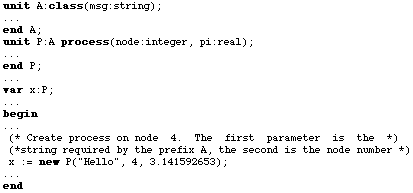 13) Concurrent processes
13) Concurrent processes
Loglan 82, A micro-manual of the programming language - Basic constructs and facilities
 13) Concurrent processes
13) Concurrent processes
Loglan allows to create and execute objects-processes. They can operate simultaneously on different computers linked into a LAN network or a few processes can share one processor (its time-slices).
Process modules are different from the classes and coroutines for, they use the keyword process. The syntax of process modules is otherwise the same. In a process one can use a few more instructions: resume (resume a process which is passive), stop - make the current process passive, etc.
All processes (even those executed on the same computer) are implemented as distributed, i.e. without any shared memory. This fact implies some restrictions on how processes may be used. Not all restrictions are enforced by the present compiler, so it is the programmer's responsibility to respect them. For the details see the User's Manual.
Semantics of the generator new is slightly modified when applied to the processes. The first parameter of the first process unit in the prefix sequence must be of type INTEGER. This parameter denotes the node number of the computer on which this process will be created. For a single computer operation this parameter must be equal to 0.
Example:

COMMUNICATION MECHANISM
Processes may communicate and synchronize by a mechanism based on rendez-vous. It will be referred to as "alien call" in the following description.
An alien call is either:
Every process object has an enable mask. It is defined as a subset of all procedures declared directly inside a process unit or any unit from its prefix sequence (i.e. subset of all procedures that may be alien-called).
A procedure is enabled in a process if it belongs to that process' enable mask. A procedure is disabled if it does not belong to the enable mask.
Immediately after generation of a process object its enable mask is empty (all procedures are disabled).
Semantics of the alien call is different from the remote call described in the report. Both the calling process and the process in which the procedure is declared (i.e. the called process) are involved in the alien call. This way the alien call may be used as a synchronization mechanism.
The calling process passes the input parameters and waits for the call to be completed.
The alien-called procedure is executed by the called process. Execution of the procedure will not begin before certain conditions are satisfied. First, the called process must not be suspended in any way. The only exception is that it may be waiting during the ACCEPT statement (see below). Second, the procedure must be enabled in the called process.
When the above two conditions are met the called process is interrupted and forced to execute the alien-called procedure (with parameters passed by the calling process).
Upon entry to the alien-called procedure all procedures become disabled in the called process.
Upon exit the enable mask of the called process is restored to that from before the call (regardless of how it has been changed during the execution of the procedure). The called process is resumed at the point of the interruption. The execution of the ACCEPT statement is ended if the called process was waiting during the ACCEPT (see below). At last the calling process reads back the output parameters and resumes its execution after the call statement.
The process executing an alien-called procedure can easily be interrupted by another alien call if the enable mask is changed.
There are some new language constructs associated with the alien call mechanism. The following statements change the enable mask of a process:

enables the procedures with identifiers p1, ..., pn. If there are any processes waiting for an alien call of one of these procedures, one of them is chosen and its request is processed. The scheduling is done on a FIFO basis, so it is strongly fair. The statement:

disables the procedures with identifiers p1, ..., pn.
In addition a special form of the RETURN statement:

allows to enable the procedures p1, ..., pn and disable the procedures q1,...,qn after the enable mask is restored on exit from the alien-called procedure. It is legal only in the alien-called procedures (the legality is not enforced by the compiler).
A called process may avoid busy waiting for an alien call by means of the ACCEPT statement:

adds the procedures p1, ..., pn to the current mask, and waits for an alien call of one of the currently enabled procedures. After the procedure return the enable mask is restored to that from before the ACCEPT statement.
Note that the ACCEPT statement alone (i.e. without any ENABLE/DISABLE statements or options) provides a sufficient communication mechanism. In this case the called process may execute the alien-called procedure only during the ACCEPT statement (because otherwise all procedures are disabled). It means that the enable mask may be forgotten altogether and the alien call may be used as a pure totally synchronous rendez-vous. Other constructs are introduced to make partially asynchronous communication patterns possible.
Below find a complete listing of a simple example - monitors.
